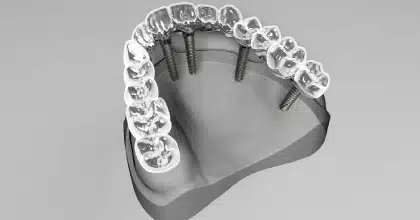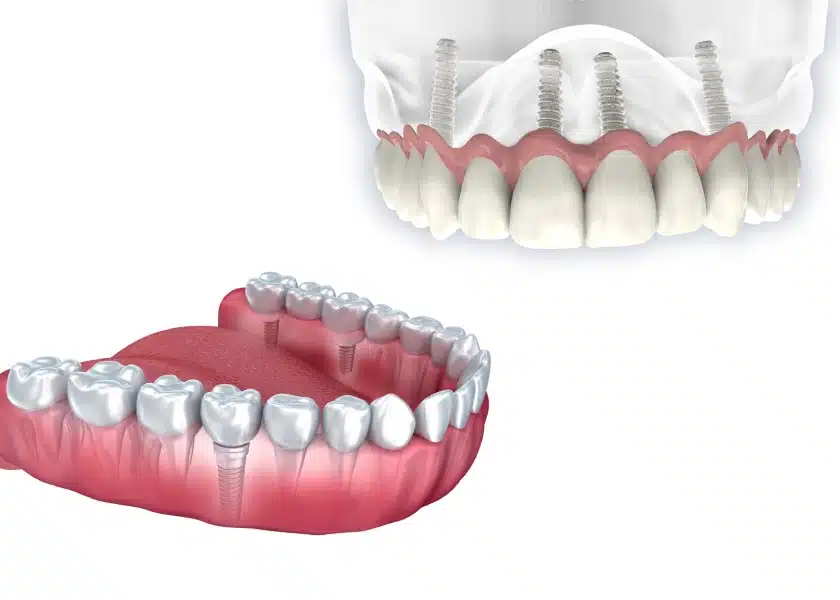The comparison between “All on 4 vs Traditional Dental Implants” emerges as a pivotal discussion in contemporary dentistry, particularly concerning full-arch tooth replacement solutions. As adults face the common challenge of missing teeth due to shifts in diet and lifestyle, the need for effective replacement techniques becomes increasingly apparent.
At Diamond Dental, we recognize the importance of addressing missing teeth promptly. That’s why we offer both All 4 Dental Implants and traditional dental implants, each with distinct characteristics and cost considerations. If you’re navigating the choices for replacing missing teeth, our dentists in Bellingham, WA, can guide you in choosing the most suitable option for your dental health and lifestyle needs.
What are Traditional Dental Implants?
Traditional dental implants serve to replace a single tooth or multiple teeth. They include single-tooth implants surgically placed into the jawbone, bone grafting procedures to restore jawbone structure, and overdentures designed to replace multiple teeth.
These implants are invasive and typically require nearly a year for full completion. The process necessitates at least two surgical procedures for success and involves the placement of each tooth individually.
Implants play a vital role in addressing the issue of one or multiple missing teeth, offering a permanent solution to restore dental function.

What Are All-on-4 Dental Implants?
Dentists use All-on-4 dental implants as a modern technique to replace missing teeth, particularly when individuals have lost most of their teeth due to infection or accidents. This method is applicable to either the upper or lower arch and involves the placement of only four implants to replace the entire arc of teeth.
All-on-4 vs Traditional Dental Implants Procedure
Aspect | All-on-4 Dental Implants | Traditional Dental Implants |
Number of Implants | Typically four implants per arch | One implant per missing tooth or multiple implants |
Bone Grafting | Usually not required | Often necessary depending on bone density and volume |
Surgical Procedure | Less invasive, often completed in a single surgery | More invasive, and requires multiple surgeries |
Treatment Time | Generally faster, with a shorter recovery period | Longer treatment duration, spanning several months |
Prosthetic Attachment | Immediate placement of prosthetic teeth | Delayed attachment of prosthetic teeth |
Restoration Completion | Typically completed within a few months | Takes close to a year to be fully completed |
Why Choose All-on-4 over Traditional Dental Implants?
When considering all-on-4 vs. traditional dental implants, it’s crucial to consult with a professional dentist to know the advantages and disadvantages of each approach. Nonetheless, All-on-4 dental implants are often preferred for the following reasons:
- Speed: All-on-4 implants offer a much quicker solution compared to traditional implants. The All-on-4 procedure typically takes around 2-3 days, whereas traditional implants may require extensive healing time, often lasting 12 months or more due to the need for bone grafting.
- Cost: Traditional implants tend to be more expensive, primarily because they frequently necessitate bone grafting to address bone loss. This additional procedure is complex and comes with added expenses. Moreover, the cost of traditional implants rises as multiple individual implants are required.
- Invasiveness: All-on-4 implants are less invasive as they only involve the placement of four implants, whereas the traditional method may require four to eight implants to achieve the same outcome.
- Bone Grafting: Unlike traditional implants, All-on-4 implants typically do not require bone grafting. Instead, the implants are positioned in areas of the jawbone with high bone density. Traditional implants, on the other hand, often necessitate bone grafting due to the placement of multiple implants across the dental arch.
- Full Arch Replacement: All-on-4 is an ideal option for replacing an entire dental arch, accomplishing this with only four implants.
- Appointment Frequency: The All-on-4 implant procedure requires fewer appointments compared to traditional implants, making it a more convenient option for many patients.
- Aesthetics: All-on-4 implants can greatly enhance your smile’s appearance, as they can be customized to look incredibly natural and visually appealing.
Considering these factors, All-on-4 implants present a compelling alternative to traditional dental implants for individuals seeking efficient, cost-effective, and aesthetically pleasing tooth replacement solutions.
Which Option Should You Choose?
The decision between All-on-4 vs traditional implants is based on several factors, including the number of missing teeth, their location, and the density of your jawbone. In certain cases, traditional implants may be the optimal choice, while All-on-4 implants may be more suitable in other cases.
For example, if you have a single missing tooth, a traditional implant may be the most appropriate solution. On the other hand, if you have lost all the teeth in either your upper or lower jaw, All-on-4 implants may offer the best outcome.
Ready to explore your options for dental implants? Schedule a consultation with our experienced dentists at Diamond Dental, Bellingham, WA, to discuss whether All-on-4 or traditional dental implants are the right choice for you. For new patients, please call (360) 516-4610, while all other callers can reach us at (360) 734-1999.
FAQs
All-on-4 implants utilize four implants to replace an entire dental arch, whereas traditional implants replace individual teeth and may require bone grafting.
All-on-4 implants typically have a faster recovery time and require fewer appointments compared to traditional implants.
While the initial cost of All-on-4 implants may be higher, they may be more cost-effective in the long run due to fewer required procedures and appointments. However, the overall cost depends on individual factors and treatment plans.








